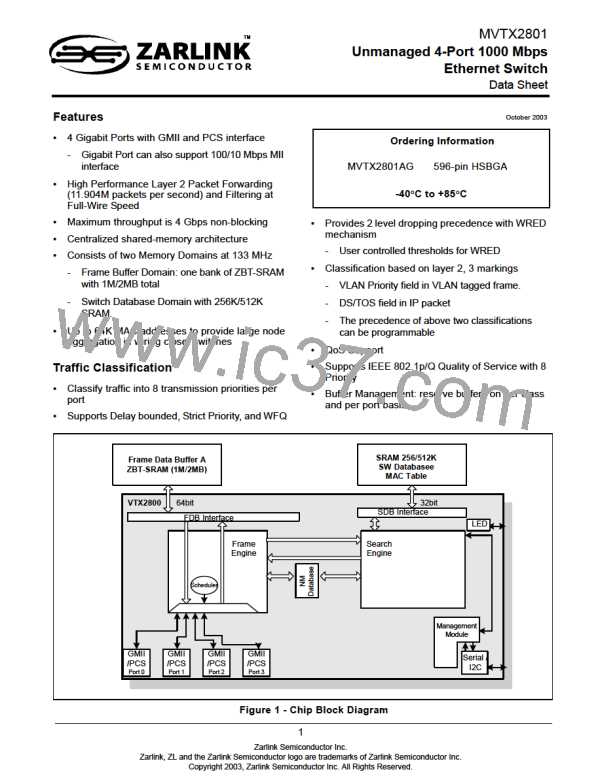MVTX2801
Data Sheet
The search engine retrieves the VLAN member ports from the VLAN index table, which consists of 4K entries.
The search engine retrieves the VLAN member ports from the ingress port's VLAN map. Based on the destination
MAC address, the search engine determines the egress port from the MCT database. If the egress port is a member
of a trunk group, the packet can be distributed to the other members of that trunk group. The VLAN map is used to
check whether the egress port is a member of the VLAN, based on the ingress port. If it is a member, the packet is
forwarded otherwise it is discarded.
8.3 Multicast Packet Forwarding
For multicast packet forwarding, the device must determine the proper set of ports from which to transmit the packet
based on the VLAN index and hash key.
Two functions are required in order to distribute multicast packets to the appropriate destination ports in a port
trunking environment.
•
•
Determining one forwarding port per group.
For multicast packets, all but one port per group, the forwarding port, must be excluded.
8.4 Preventing Multicast Packets from Looping Back to the Source Trunk
The search engine needs to prevent a multicast packet from sending to a port that is in the same trunk group with
the source port. This is because, when we select the primary forwarding port for each group, we do not take the
source port into account. To prevent this, we simply apply one additional filter, so as to block that forwarding port for
this multicast packet.
9.0 LED Interface
9.1 Introduction
The MVTX2801 LED block provides two interfaces: a serial output channel, and a parallel time-division interface.
The serial output channel provides port status information from the MVTX2801 chip in a continuous serial stream.
This means that a low cost external device must be used to decode the serial data and to drive an LED array for
display.
By contrast, the parallel time-division interface supports a glueless LED module. Indeed, the parallel interface can
directly drive low-current LEDs without any extra logic. The pin LED_PM is used to select serial or parallel mode.
For some LED signals, the interface also provides a blinking option. Blinking may be enabled for LED signals TxD,
RxD, COL, and FC (to be described later). The pin LED_BLINK is used to enable blinking, and the blinking frequency
is around 160 ms.
9.2 Serial Mode
In serial mode, the following pins are utilized:
•
•
•
LED_SYNCO - a sync pulse that defines the boundary between status frames
LED_CLKO - the clock signal
LED_DO - a continuous serial stream of data for all status LEDs that repeats once every frame time
In each cycle (one frame of status information, or one sync pulse), 16x8 bits of data are transmitted on the LED_DO
signal. The sequence of transmission of data bits is as shown in the figure below:
25
Zarlink Semiconductor Inc.

 ZARLINK [ ZARLINK SEMICONDUCTOR INC ]
ZARLINK [ ZARLINK SEMICONDUCTOR INC ]